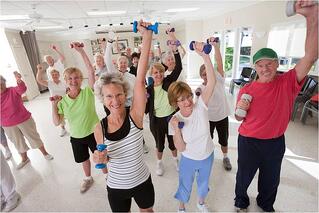
If you can't answer these questions about your community fitness program, it's time to consider doing something more with the data you're gathering to create a more effective offering for your residents:
- Do you know how many classes you offered last month and which residents attended compared to the preceding month?
- Do you know how many appointments were conducted in the fitness center last year compared to this year?
- Does your tracking for fitness center or class attendance allow you to see individual participation trends by resident?
In many communities with which we work, there is often some type of sign in practice in place, but typically little to nothing is done with that information once the resident signs his name on the way into the fitness center. Consistent participation tracking is even less common in the group fitness classes; it's more common to simply estimate headcounts.
Tracking resident participation in all of your offerings is central to highlighting the value of your fitness program and continuing to evolve what you are doing. Read on to discover three key ways participation data can help you provide more effective programming in your senior living community fitness center.
1. Create Visit Goals for the Residents
By keeping record of how many total visits you have to your fitness center, pool, and group fitness offerings, you can determine the ebbs and flows in participation through the year. As the busy holiday season approaches and exercise routines get pushed to the back burner, set a community goal for your residents to accumulate more visits in December of this year as opposed to last year. We’ve seen firsthand how residents LOVE to rally together as a team for goals like this. Providing them with weekly updates on their standings has helped us reach visit goals and prevented lulls in participation. You won’t know what a reasonable goal is, however, if you don’t have historical data to evaluate.
[Related Content: Increasing Participation in Senior Living Fitness Programs]
2. Reach Out to Individuals
Your tracking system should allow you to see how many times any given resident participates in part(s) of the program. If someone comes to a particular exercise class six times a month and the fitness center nine times a month, you should have that information at your fingertips through proper tracking procedures. Then you can recognize their efforts through recognition programs such as a monthly “Fit 15” listing. Similarly, if you have a resident who joined the program but stopped coming, you’ll have that important information at your fingertips. Personally contacting a resident and letting them know that their participation is missed and inviting them back to an old favorite or a fresh new opportunity can be a great tool for improving exercise adherence.
Let's be clear: We’re talking about tracking attendance by resident; that’s the only way this will work. Taking simple headcounts for total visits in your program will not allow you to consistently evaluate the specific members who make up your participation and create those avenues for personal connection and recognition.
3. Demonstrate Value
Having participation data that shows you monthly totals for your different offerings will allow you to evaluate what is effective, what is gaining or losing momentum, and what might be ready for a change. By sticking with a group fitness class on the calendar that has only two or three consistent participants, you might be limiting resources that could go toward a fresh new offering that would cater to the needs and interests of more individuals. Residents will be much more able to embrace change when you can show them the data and well-thought-out intentions behind it.
Similarly, if you feel your program cannot expand further without additional resources, let the data demonstrate the value in your current offerings. If an exercise class is busting at the seams, have a few months worth of data to show the growth and articulate the need for another class on the schedule. If your fitness center participation is increasing, use the monthly visit and appointment data to demonstrate the need for additional staffing support or more equipment.
[Related Content: Benefits of Tracking Participation Data]
***
Don’t shy away from data. It can support important decisions about the future of your fitness program. Start small with a simple list of all the residents in the community and invite them to start checking in. From there, you can build basic spreadsheets to create a tracking tool that will help you determine what parts of your community’s fitness program need the most attention. Or, reach out to us for NIFS consulting services - we'll provide you with the tools to get off the ground quickly with improvements to your fitness program that boost your senior living community.

